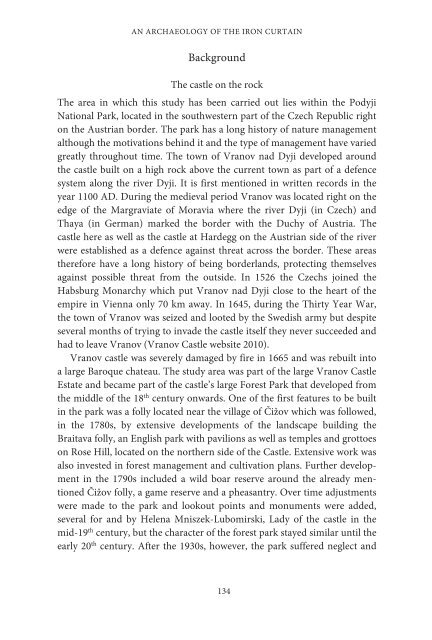1JZGauQ
1JZGauQ
1JZGauQ
Create successful ePaper yourself
Turn your PDF publications into a flip-book with our unique Google optimized e-Paper software.
AN ARCHAEOLOGY OF THE IRON CURTAIN<br />
Background<br />
The castle on the rock<br />
The area in which this study has been carried out lies within the Podyji<br />
National Park, located in the southwestern part of the Czech Republic right<br />
on the Austrian border. The park has a long history of nature management<br />
although the motivations behind it and the type of management have varied<br />
greatly throughout time. The town of Vranov nad Dyji developed around<br />
the castle built on a high rock above the current town as part of a defence<br />
system along the river Dyji. It is first mentioned in written records in the<br />
year 1100 AD. During the medieval period Vranov was located right on the<br />
edge of the Margraviate of Moravia where the river Dyji (in Czech) and<br />
Thaya (in German) marked the border with the Duchy of Austria. The<br />
castle here as well as the castle at Hardegg on the Austrian side of the river<br />
were established as a defence against threat across the border. These areas<br />
therefore have a long history of being borderlands, protecting themselves<br />
against possible threat from the outside. In 1526 the Czechs joined the<br />
Habsburg Monarchy which put Vranov nad Dyji close to the heart of the<br />
empire in Vienna only 70 km away. In 1645, during the Thirty Year War,<br />
the town of Vranov was seized and looted by the Swedish army but despite<br />
several months of trying to invade the castle itself they never succeeded and<br />
had to leave Vranov (Vranov Castle website 2010).<br />
Vranov castle was severely damaged by fire in 1665 and was rebuilt into<br />
a large Baroque chateau. The study area was part of the large Vranov Castle<br />
Estate and became part of the castle’s large Forest Park that developed from<br />
the middle of the 18 th century onwards. One of the first features to be built<br />
in the park was a folly located near the village of Čižov which was followed,<br />
in the 1780s, by extensive developments of the landscape building the<br />
Braitava folly, an English park with pavilions as well as temples and grottoes<br />
on Rose Hill, located on the northern side of the Castle. Extensive work was<br />
also invested in forest management and cultivation plans. Further development<br />
in the 1790s included a wild boar reserve around the already mentioned<br />
Čižov folly, a game reserve and a pheasantry. Over time adjustments<br />
were made to the park and lookout points and monuments were added,<br />
several for and by Helena Mniszek-Lubomirski, Lady of the castle in the<br />
mid-19 th century, but the character of the forest park stayed similar until the<br />
early 20 th century. After the 1930s, however, the park suffered neglect and<br />
134




